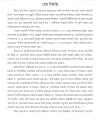Dipak Kurmi
The Ambubachi Mela is one of the most significant and intriguing religious gatherings in eastern India. Held annually at the renowned Kamakhya Temple in Guwahati, Assam, this festival draws hundreds of thousands of devotees and curious onlookers from across India and beyond. The mela, which typically takes place in June during the monsoon season, is a fascinating blend of ancient fertility rituals, Tantric traditions, and Hindu worship practices. At its core, the Ambubachi Mela is a celebration of the divine feminine and the power of creation. The festival centers around the belief that the presiding goddess of the Kamakhya Temple, Devi Kamakhya, undergoes her annual menstrual cycle during this time. This unique concept sets Ambubachi Mela apart from many other Hindu festivals and provides insight into the region's rich cultural and spiritual heritage. The Kamakhya Temple and Its Significance: The Kamakhya Temple, perched atop the Nilachal Hills in western Guwahati, is one of the most revered Shakti shrines in India. What makes this temple particularly special is that there is no traditional idol of the goddess. Instead, Devi Kamakhya is worshipped in the form of a yoni-like stone over which a natural spring flows. This symbolism is deeply tied to the temple's focus on fertility and the creative power of the feminine. According to Hindu mythology, the temple marks the spot where Sati's yoni (female genitalia) fell to earth after Lord Shiva carried her dismembered body across the land in grief. This legend imbues the site with immense spiritual significance and connects it to the broader narrative of Shakti worship in Hinduism. The Festival Timeline: The Ambubachi Mela typically lasts for four days, with the most intense activities occurring at the beginning and end of the festival. Here's a breakdown of the event: 1. Closing of the Temple: On the first day, the temple doors are closed to all devotees. This marks the beginning of the goddess's menstrual period. 2. Period of Restrictions: For the next three days, the temple remains closed. During this time, devotees observe various restrictions as a sign of respect for the goddess's state. These include refraining from cooking, performing puja, reading holy books, and engaging in farming activities. 3. Purification and Reopening: On the fourth day, elaborate rituals are performed to bathe and purify the goddess. The temple doors are then reopened, allowing devotees to enter and receive darshan (view) of the deity. 4. Distribution of Prasad: After the reopening, special prasad (blessed offerings) is distributed to the faithful. This prasad comes in two forms: Angodak, which is water from the spring that flows over the stone yoni, and Angabastra, a piece of the red cloth used to cover the yoni during the days of menstruation. Tantric Connections and Spiritual Practices: The Ambubachi Mela is deeply intertwined with Tantric traditions, which have a strong presence in eastern India. During the festival, the usually secluded Kamakhya Temple becomes a hub for Tantric practitioners and devotees. Many Tantric babas (holy men) make rare public appearances during these four days, emerging from their year-round seclusion to participate in the festivities. The gathering attracts a diverse array of spiritual seekers, including: • Sadhus and sadhvis (holy men and women) with long matted hair • Black-clad Aghora ascetics • Khade-babas (standing babas) • Bauls (mystical minstrels from Bengal) • Intellectual and folk Tantrics Many of these practitioners claim to possess extraordinary psychic and spiritual powers. Some perform public demonstrations of their abilities, such as standing on one leg for hours or balancing their entire body weight on their heads. These displays add to the festival's mystical atmosphere and attract curious onlookers from around the world. Fertility Rituals and Blessings: Given its association with the goddess's menstrual cycle, the Ambubachi Mela is strongly connected to concepts of fertility and creation. Many couples struggling with infertility attend the festival, seeking blessings and miracle cures from the goddess and the assembled holy men.




















0 Comments